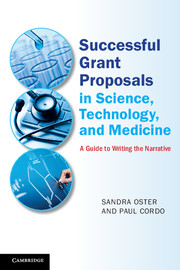Book contents
- Frontmatter
- Dedication
- Contents
- Preface and Acknowledgments
- 1 The Scientific Grant Proposal and Its Narrative
- 2 The Aims Section
- 3 The Background Section
- 4 The Preliminary Studies/Progress Report Section
- 5 The Methods Section, Part 1
- 6 The Methods Section, Part 2
- 7 Other prose considerations
- 8 Technical features of sentences
- Glossary
- Index
- References
5 - The Methods Section, Part 1
Published online by Cambridge University Press: 05 September 2015
- Frontmatter
- Dedication
- Contents
- Preface and Acknowledgments
- 1 The Scientific Grant Proposal and Its Narrative
- 2 The Aims Section
- 3 The Background Section
- 4 The Preliminary Studies/Progress Report Section
- 5 The Methods Section, Part 1
- 6 The Methods Section, Part 2
- 7 Other prose considerations
- 8 Technical features of sentences
- Glossary
- Index
- References
Summary
Most grant applications fail because of problems in the Methods Section. You need to provide enough detailed, accurate, and clear methods information for reviewers:
To understand your proposed research design and methods.
To understand why you decided on particular features of your proposed research design and methods.
To conclude that your proposed research design and methods will result in valid findings.
To conclude that your proposed research design and methods are appropriate for you to achieve your proposed research objective and aims.
To conclude that your proposed research design represents sound scientific methodology.
To conclude that you, personally or through members of your research team, can successfully execute all of your proposed methods.
To visualize your executing the proposed methods in a logical order.
To view your credibility favorably.
In addition, you need to provide enough detailed, clear, and accurate information so that researchers – with your same or closely similar training and background – can (at least in theory) replicate your methods and come up with essentially the same data, results, and statistical analyses that you are proposing to achieve.
Chapter 5 covers basic organizational alternatives for the Methods Section and information to include when you are: (a) presenting your proposed research design and methods, (b) describing your SOS (subjects, objects of study, and specimens), and (c) describing your MET (materials, equipment, and tools). Chapter 6 focuses on how to draft procedures for collecting data and analyzing the data; and how to explain your potential methodological problems and proposed solutions. Chapter 6 includes guidelines on how to organize the Methods Section when some of the methodological features are the same or similar across aims or experiments – that is, when some of the methodological features are shared across the proposed aims or experiments. Chapter 6 also discusses the ending to the narrative.
- Type
- Chapter
- Information
- Successful Grant Proposals in Science, Technology, and MedicineA Guide to Writing the Narrative, pp. 143 - 196Publisher: Cambridge University PressPrint publication year: 2015



